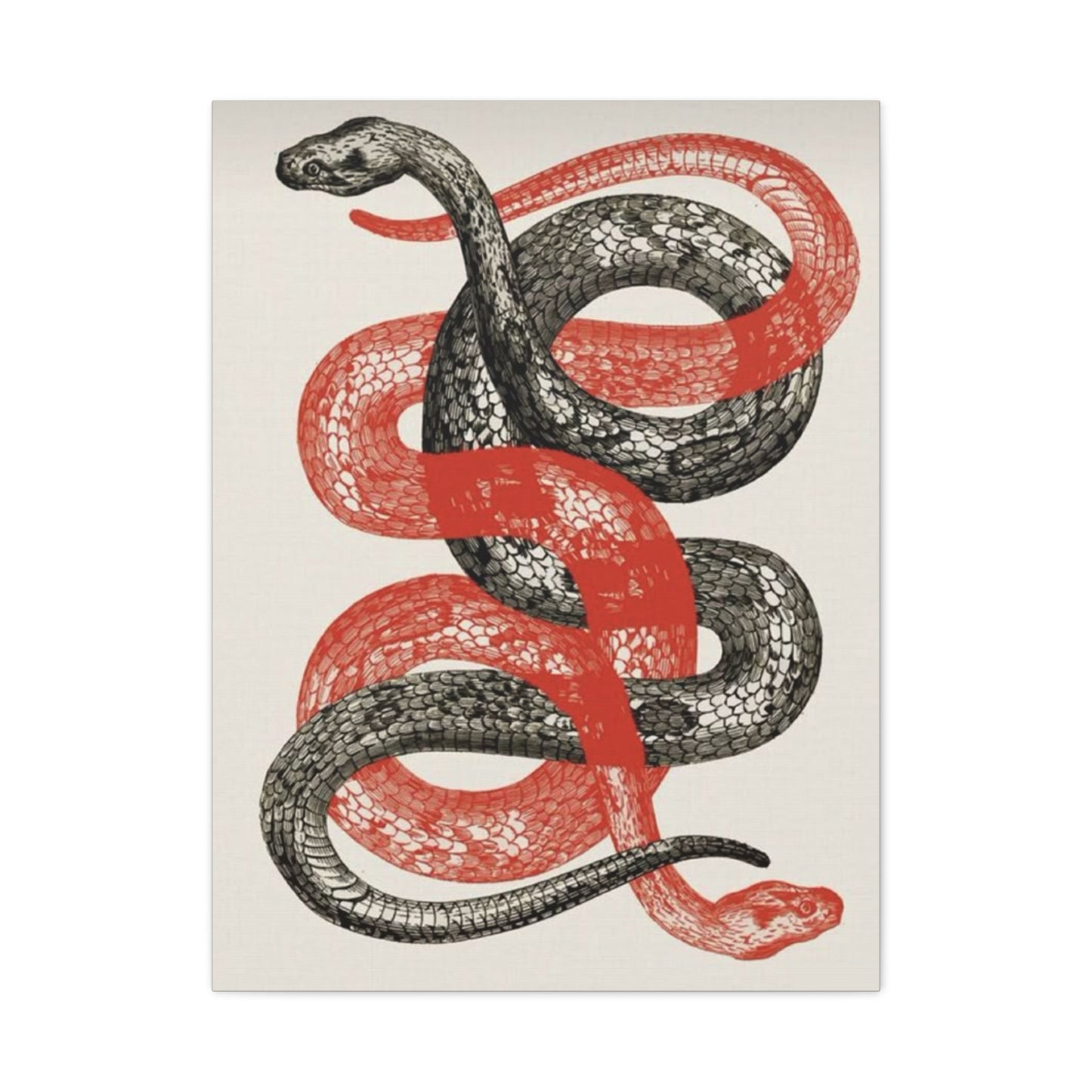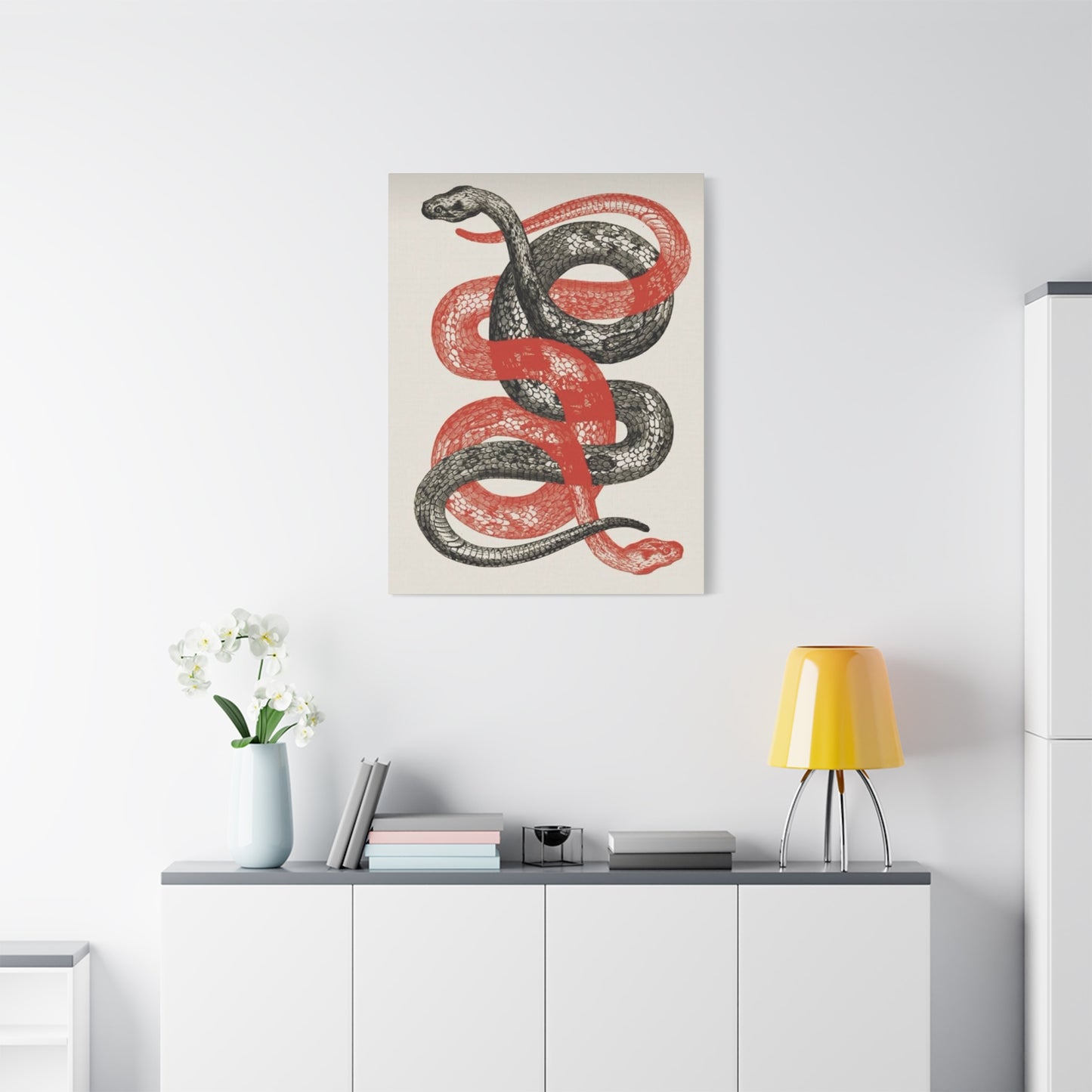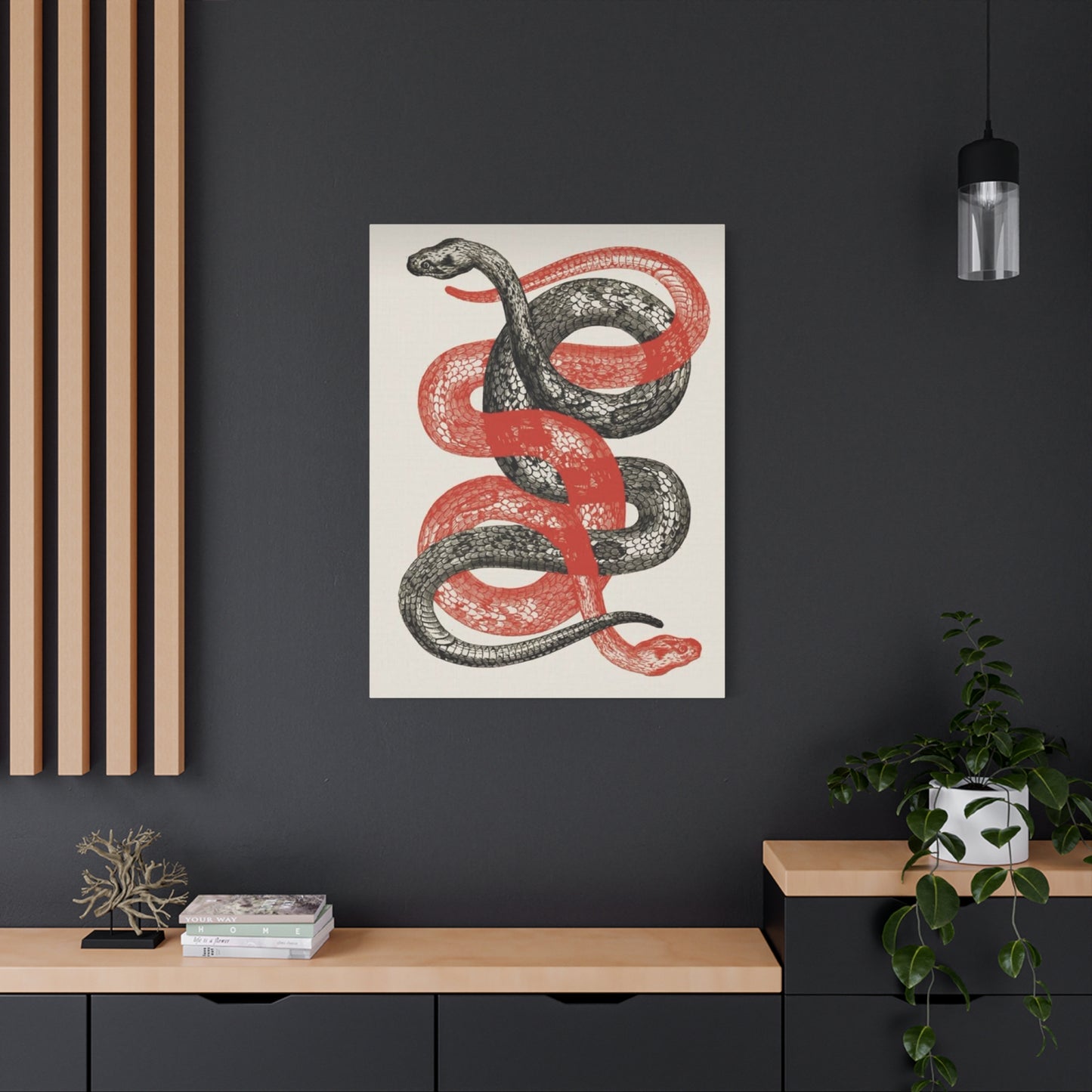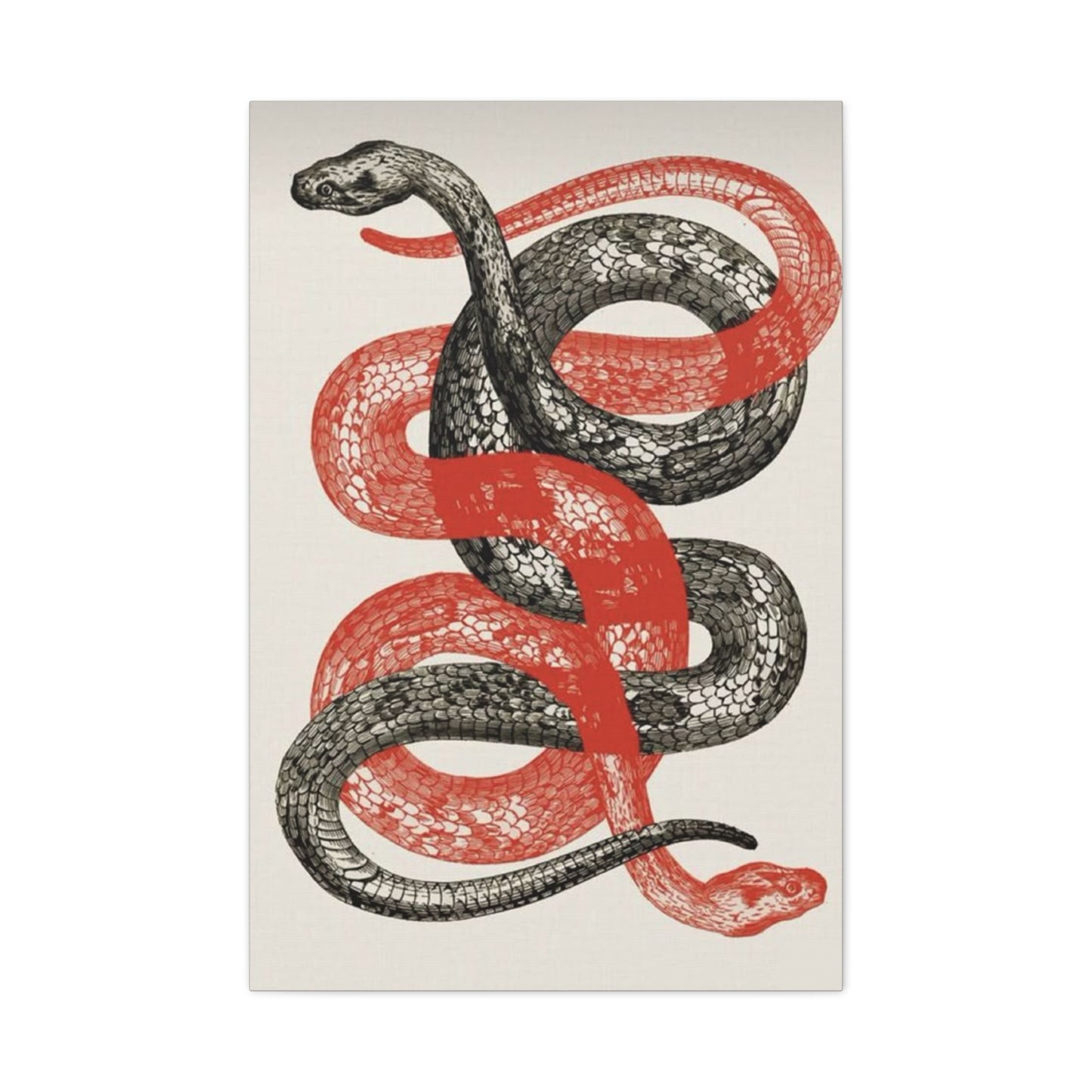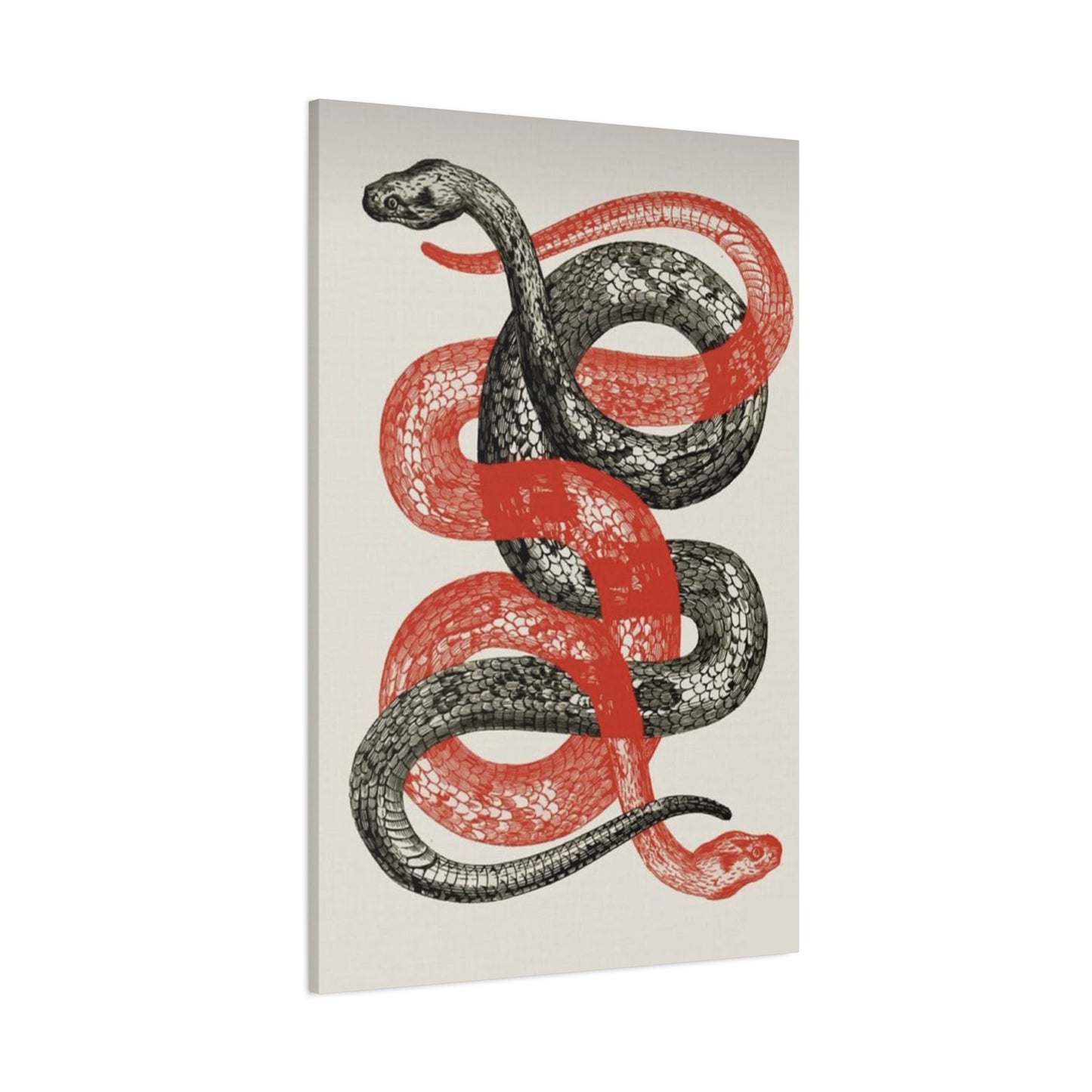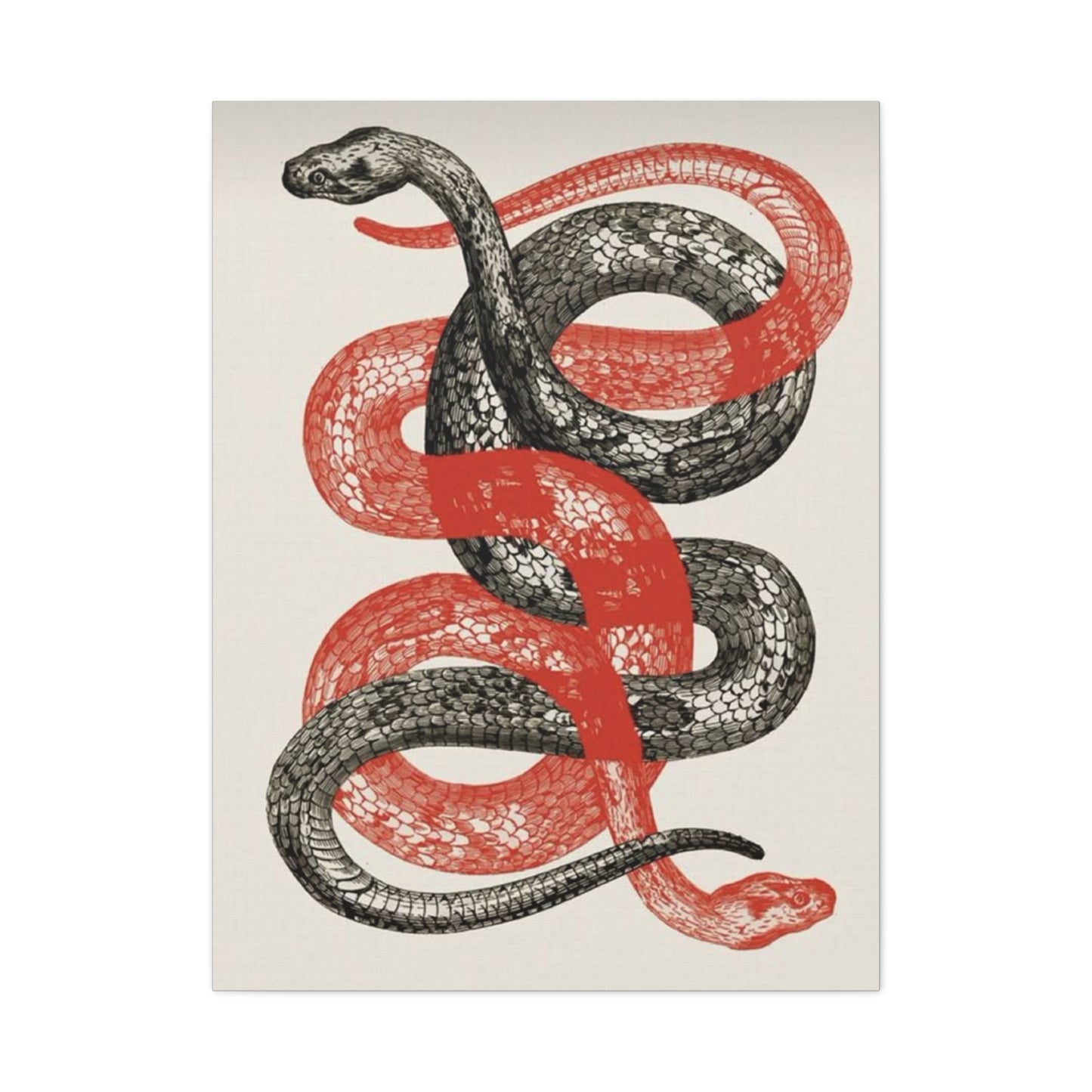Red and Black Snake Wall Art: Powerful Symbolism and Bold Decor Choices
Snake imagery has captivated human imagination for millennia, representing a complex tapestry of meanings that transcend cultural boundaries. When artists combine the powerful symbolism of serpents with the striking color combination of red and black, they create pieces that resonate on multiple psychological and spiritual levels. These colors themselves carry profound significance - red embodies passion, energy, life force, and sometimes danger or warning, while black represents mystery, sophistication, the unknown, and often rebirth or transformation.
The serpent's symbolic nature varies dramatically across different belief systems and historical contexts. In many ancient civilizations, snakes were revered as symbols of wisdom, healing, and renewal, primarily due to their ability to shed their skin and emerge seemingly reborn. The ancient Greek god of medicine, Asclepius, was often depicted with a serpent-entwined staff, a symbol that persists in modern medical iconography. Similarly, in Hindu and Buddhist traditions, the serpent or Naga represents divine protection, cosmic energy, and the kundalini - the spiritual energy that lies dormant at the base of the spine.
The duality of snake symbolism becomes particularly pronounced when examining their role in various mythologies. While Western Christian tradition often portrays the serpent as a symbol of temptation and evil, stemming from the biblical story of Eden, many other cultures view snakes as guardians of sacred knowledge and protectors of divine secrets. In ancient Egypt, the cobra was a symbol of royal power and divine protection, adorning the crowns of pharaohs as the uraeus. This protective aspect is echoed in many African traditions where serpents are seen as ancestral spirits or guardians of the earth.
The psychological impact of red and black snake art taps into these deep-seated symbolic associations. The combination creates a visual tension that can be both alluring and intimidating, reflecting the dual nature of serpent symbolism itself. Red, being the color of blood and fire, adds intensity and vitality to the snake imagery, while black provides depth, mystery, and a sense of the primordial. This color pairing is particularly effective in creating artwork that commands attention and provokes emotional responses.
Contemporary interpretations of snake symbolism in art often focus on themes of transformation, power, and personal growth. The snake's ability to shed its skin has become a metaphor for personal reinvention, making red and black snake art particularly appealing to those undergoing significant life changes or seeking to embrace their inner strength. The bold color combination reinforces these themes, with red representing the courage needed for transformation and black symbolizing the mystery and depth of the process.
Artists working with snake imagery often explore the creature's inherent contradictions - its simultaneous association with both healing and harm, wisdom and temptation, creation and destruction. This complexity makes snake art particularly suitable for those who appreciate layered meanings and symbolic depth in their decorative choices. The serpent's sinuous form also provides artists with endless opportunities for creative interpretation, from highly stylized geometric representations to flowing, organic forms that capture the creature's natural grace.
The cultural significance of snakes extends beyond religious and mythological contexts into the realm of psychology and personal symbolism. Carl Jung identified the serpent as a powerful archetype representing the unconscious mind and the process of individuation. This psychological dimension adds another layer of meaning to red and black snake art, making it appealing to those interested in personal development and self-discovery.
In contemporary culture, snake imagery has been reclaimed and reinterpreted in various contexts, from fashion and jewelry to tattoo art and home decoration. The use of red and black in snake art particularly appeals to those who want to make bold statements about their personality or aesthetic preferences. These colors convey confidence, sophistication, and a willingness to embrace both beauty and danger.
The enduring appeal of snake symbolism in art reflects humanity's complex relationship with these creatures. Despite common fears and prejudices, snakes continue to fascinate us with their mysterious nature and symbolic richness. Red and black snake art captures this fascination while providing a sophisticated and dramatic element for modern living environments.
How Red and Black Snake Wall Art Adds Drama to Rooms
The introduction of red and black snake wall art into residential or commercial environments creates an immediate focal point that transforms the entire atmosphere of a room. This dramatic effect stems from both the psychological impact of the imagery and the powerful visual contrast created by the color combination. When strategically placed, such artwork can completely alter the perceived energy and character of any environment, making it an invaluable tool for those seeking to create memorable and impactful living or working areas.
The dramatic effect begins with the inherent power of the serpent image itself. Snakes, with their sleek, sinuous forms and mysterious nature, naturally draw the eye and hold attention. When rendered in the bold combination of red and black, this magnetic quality is amplified significantly. Red, being one of the most attention-grabbing colors in the spectrum, immediately commands visual focus, while black provides depth and sophistication that prevents the artwork from appearing merely flashy or superficial.
In living rooms, red and black snake wall art can serve as a conversation starter and a reflection of the homeowner's bold aesthetic choices. The placement of such artwork above a sofa or fireplace creates a natural gathering point for guests, while the dramatic imagery encourages discussion and engagement. The sophisticated color palette ensures that the piece can complement various design schemes without overwhelming the room's existing elements.
Bedrooms benefit from the passionate yet mysterious qualities of red and black snake art. The red elements can add warmth and energy to the room, while the black components provide a sense of intimacy and sophistication. This combination can enhance the romantic atmosphere of a master bedroom while maintaining an air of mystery and allure. The serpentine forms can also create a sense of movement and flow that makes the room feel more dynamic and alive.
In professional environments such as offices or creative studios, red and black snake wall art can project confidence, creativity, and a willingness to take bold risks. The powerful imagery can serve as a source of inspiration and motivation, while the sophisticated color scheme maintains professionalism. Law offices, creative agencies, and consulting firms often find that such dramatic artwork helps establish their brand identity and creates memorable impressions on clients.
Dining rooms particularly benefit from the dramatic flair that red and black snake art provides. The colors can stimulate appetite and conversation, while the intriguing imagery provides guests with something compelling to discuss throughout the meal. The sophisticated nature of the artwork ensures that it enhances rather than detracts from the dining experience.
The lighting in a room significantly affects how red and black snake art is perceived and the level of drama it creates. Under warm lighting, the red elements glow with intensity while the black areas appear rich and velvety. Cool lighting can make the black elements appear more stark and modern, while the red becomes more subdued but still maintains its visual impact. Strategic lighting placement can be used to create shadows and highlights that emphasize the serpentine forms and add to the overall dramatic effect.
The scale of the artwork also plays a crucial role in determining its dramatic impact. Large-scale pieces dominate a room and create a bold statement, while smaller pieces can provide subtle drama and intrigue. Multiple smaller pieces can be arranged to create a gallery wall that tells a story or explores different aspects of snake symbolism and aesthetics.
Popular Styles for Red and Black Snake Paintings
The world of red and black snake paintings encompasses a diverse range of artistic styles, each offering unique aesthetic qualities and emotional impacts. These styles range from traditional realistic representations to completely abstract interpretations, allowing collectors and decorators to choose pieces that best suit their personal tastes and environmental needs. Understanding these different approaches helps in making informed decisions about which style will work best in specific settings and contexts.
Realistic snake paintings represent perhaps the most traditional approach to this subject matter. These works focus on accurate anatomical representation, detailed scales, and natural poses that capture the essential character of various snake species. Artists working in this style often study snake anatomy extensively, paying careful attention to the way light reflects off scales, the patterns of natural coloration, and the graceful curves of the serpent's body. When executed in red and black, realistic snake paintings can be particularly striking, as these colors may represent actual species coloration or artistic interpretation of natural patterns.
The photorealistic style takes accuracy to an extreme level, creating paintings that are nearly indistinguishable from photographs. These works require exceptional technical skill and patience, as artists must render every detail with precision. In red and black snake paintings, photorealistic artists might focus on species that naturally display these colors, such as certain milk snakes or king snakes, or they might use artistic license to reimagine familiar species in this dramatic color scheme.
Impressionistic snake paintings emphasize mood and atmosphere over precise detail. Artists working in this style use loose brushstrokes and color blending to capture the essence of serpentine movement and form. The red and black color palette in impressionistic snake art often bleeds and flows together, creating organic transitions that mirror the fluid movement of actual snakes. This style is particularly effective for creating dreamy, mysterious atmospheres that emphasize the emotional and symbolic aspects of snake imagery.
Abstract snake paintings abandon literal representation in favor of exploring form, color, and movement in more conceptual ways. These works might use serpentine curves and sinuous lines to suggest snake-like movement without depicting recognizable snake anatomy. The red and black color palette becomes a tool for creating visual tension, rhythm, and emotional impact rather than representing actual coloration. Abstract snake art allows for highly personal interpretation and can work well in modern, minimalist environments.
Geometric snake art applies mathematical precision and structured forms to snake imagery. These paintings might break down serpentine forms into angular segments, use repetitive patterns inspired by snake scales, or create stylized representations using circles, triangles, and other geometric shapes. The red and black color scheme in geometric snake art often follows strict patterns or gradients, creating visually striking pieces that combine organic inspiration with structured design principles.
Surrealistic snake paintings explore the dreamlike and symbolic aspects of serpent imagery. These works might combine snake forms with other elements in impossible or fantastical ways, creating compositions that challenge perception and invite deep contemplation. The red and black palette in surrealistic snake art often carries symbolic weight, representing contrasts between life and death, passion and mystery, or conscious and unconscious states.
Pop art interpretations of snake imagery bring contemporary commercial aesthetic sensibilities to traditional animal subjects. These paintings might use bold, flat colors, comic book-style outlines, or repetitive patterns reminiscent of commercial printing techniques. Red and black snake art in the pop style often has a graphic, poster-like quality that can work well in modern, youth-oriented environments.
Traditional cultural styles represent another important category of red and black snake paintings. These works draw inspiration from specific cultural traditions, such as Native American, African, Asian, or Aboriginal art forms. Each tradition brings its own symbolic interpretations, artistic techniques, and aesthetic principles to snake imagery. The red and black color palette might hold specific cultural significance within these traditions, representing particular spiritual or ceremonial meanings.
Contemporary mixed-media approaches combine painting with other materials and techniques to create unique textures and visual effects. These works might incorporate collage elements, metallic paints, textured mediums, or three-dimensional components. Red and black snake art using mixed media can create striking contrasts between different surface qualities and add tactile interest to the visual experience.
Incorporating Snake Art into Modern Decor
Successfully integrating red and black snake wall art into contemporary living environments requires careful consideration of existing design elements, color schemes, and the overall aesthetic goals of each room. Modern decor principles emphasize clean lines, functional beauty, and harmonious color relationships, all of which must be taken into account when introducing such bold and symbolic artwork into living areas. The key lies in creating balance between the dramatic impact of the snake imagery and the sophisticated restraint that characterizes modern design sensibilities.
Modern minimalist environments provide an ideal backdrop for red and black snake art, as the clean, uncluttered aesthetic allows the artwork to command full attention without competing with other decorative elements. In these settings, a single large-scale snake painting can serve as the room's primary focal point, while the neutral background colors allow the red and black palette to achieve maximum visual impact. The serpentine forms complement the flowing lines often found in modern furniture design, creating visual harmony between art and furnishings.
Contemporary living rooms benefit from the strategic placement of red and black snake art above seating areas or as part of gallery walls. The key is to ensure that the artwork scales appropriately with the furniture and room proportions. Large sectional sofas can support substantial snake paintings, while smaller seating arrangements work better with more modestly sized pieces. The red elements in the artwork can be echoed through accent pillows, throws, or other decorative accessories, creating cohesive color relationships throughout the room.
Modern bedroom designs can incorporate red and black snake art as statement pieces above headboards or as part of asymmetrical wall compositions. The passionate associations of red combined with the mysterious qualities of black create an atmosphere that can enhance intimacy while maintaining sophisticated appeal. However, it's important to balance the intensity of the imagery with softer textures and colors elsewhere in the room to avoid overwhelming the restful nature of the bedroom environment.
Kitchen and dining areas in modern homes can benefit from the appetite-stimulating qualities of red combined with the elegance of black. Snake art in these areas should be positioned away from food preparation zones but visible from dining areas where it can serve as conversation starters during meals. The sleek forms of serpent imagery complement the clean lines of modern kitchen appliances and dining furniture.
Home offices and study areas can utilize red and black snake art to create inspiring and energizing work environments. The transformational symbolism of snakes can serve as motivation for professional growth and creative endeavors, while the bold color combination helps maintain focus and engagement. However, the artwork should be positioned to avoid creating distractions during detailed work tasks.
Hallways and transitional areas in modern homes provide excellent opportunities for incorporating snake art as dramatic accent pieces. These areas often have neutral color schemes that allow red and black artwork to create visual interest without overwhelming the functional purpose of the passage. Linear snake compositions work particularly well in narrow hallway settings, as they can visually extend the length of the corridor.
Modern bathrooms, especially master ensuite bathrooms, can accommodate red and black snake art as sophisticated decorative elements. The moisture-resistant qualities of certain art mediums make them suitable for bathroom environments, while the intimate setting allows for more personal and symbolic artwork choices. The transformational symbolism of snakes aligns well with the cleansing and renewal themes associated with bathroom functions.
Lighting plays a crucial role in successfully incorporating snake art into modern decor. Track lighting, picture lights, or strategically placed accent lighting can enhance the visual impact of the artwork while maintaining the clean aesthetic of modern lighting design. LED strip lighting can create dramatic backlighting effects that emphasize the serpentine forms without adding visual clutter.
The texture and finish of snake artwork should complement the material palette of modern interiors. Smooth, glossy finishes work well with contemporary furniture featuring glass, metal, and lacquered surfaces. Matte finishes can provide sophisticated contrast with highly polished modern materials. The frame selection should follow modern design principles, favoring clean lines and minimal ornamentation that won't compete with the artwork itself.
The Meaning of Snakes in Different Cultures
The cultural significance of serpents varies dramatically across different societies, religious traditions, and historical periods, creating a rich tapestry of meanings that inform contemporary interpretations of red and black snake wall art. Understanding these diverse cultural perspectives enhances appreciation for snake imagery and helps viewers connect with the deeper symbolic layers embedded in such artwork. This cultural diversity also explains why snake art resonates differently with people from various backgrounds and belief systems.
Ancient Egyptian civilization held snakes in particularly high regard, viewing them as symbols of protection, wisdom, and divine power. The cobra, specifically, was considered a protective deity, with the uraeus serving as a royal symbol worn on pharaonic crowns. The serpent goddess Wadjet was one of the earliest Egyptian deities, representing the protective aspect of royal power. In Egyptian mythology, the snake Apep represented chaos and was locked in eternal battle with the sun god Ra, symbolizing the ongoing struggle between order and disorder. These associations with divine protection and cosmic balance continue to influence modern interpretations of snake symbolism.
Greek mythology presents a complex relationship with serpents, encompassing both positive and negative associations. Asclepius, the god of healing and medicine, carried a staff entwined with a snake, a symbol that persists in modern medical imagery. The Oracle at Delphi was associated with Python, a serpent that guarded the sacred site before being slain by Apollo. Greek mythology also featured the Medusa, whose hair of serpents could turn viewers to stone, representing the dangerous aspect of snake symbolism. These dualistic associations reflect the Greek understanding of snakes as creatures of both wisdom and danger.
Hindu tradition views serpents, or Nagas, as divine beings associated with water, fertility, and the cosmic forces of creation. The thousand-headed serpent Shesha supports the universe in Hindu cosmology, while Kundalini, often depicted as a coiled serpent, represents spiritual energy lying dormant at the base of the spine. The god Vishnu is often depicted resting on the serpent Shesha, while Shiva wears serpents as ornaments, representing his mastery over death and time. These positive associations make snake imagery particularly meaningful in contexts related to spiritual growth and cosmic understanding.
Buddhist traditions also recognize the protective and wise aspects of serpents through the Naga kings, who are said to have protected the Buddha during his meditation. The Mucalinda, a Naga king, sheltered the Buddha from a storm during his enlightenment, making serpents symbols of protection for those seeking spiritual awakening. In Buddhist art, serpents often appear as guardians of sacred spaces and protectors of dharma teachings.
Chinese culture associates snakes with wisdom, grace, and transformation. In the Chinese zodiac, the snake year is associated with intelligence, intuition, and mysterious charm. Chinese medicine recognizes the snake's ability to shed its skin as a symbol of renewal and healing. The concept of the dragon, which shares many serpentine characteristics, represents imperial power, good fortune, and divine blessing in Chinese culture.
Native American traditions present diverse interpretations of snake symbolism, varying among different tribes and regions. Many tribes view snakes as symbols of transformation, healing, and connection to the earth. The Hopi snake dance is a ceremonial practice that honors serpents as bringers of rain and fertility. Some Plains tribes associate snakes with lightning and storm power, while Southwestern cultures often see serpents as guardians of springs and water sources.
African cultures traditionally regard serpents as ancestral spirits and symbols of wisdom. The rainbow serpent appears in many African mythologies as a creator deity associated with water, fertility, and the life force. In West African traditions, serpents are often seen as messengers between the world of the living and the realm of ancestors. The python, in particular, is revered in many African cultures as a symbol of strength, wisdom, and divine presence.
Mesoamerican civilizations, including the Aztecs and Maya, held serpents in high esteem. Quetzalcoatl, the feathered serpent deity, represented the union of earth and sky, matter and spirit. Serpents were associated with rain, fertility, and the underworld in these cultures. The ability of snakes to move between different levels of existence made them powerful symbols of transformation and spiritual journeying.
Aboriginal Australian cultures feature the Rainbow Serpent as a central creator figure in Dreamtime stories. This serpent is responsible for creating rivers, mountains, and other landscape features while also establishing laws and customs for human behavior. The Rainbow Serpent represents the life-giving power of water and the connection between all living things.
Abstract vs Realistic Red and Black Snake Art
The distinction between abstract and realistic approaches to red and black snake art represents one of the most fundamental choices facing both artists and collectors. Each approach offers unique advantages, aesthetic qualities, and emotional impacts that appeal to different sensibilities and serve different decorative purposes. Understanding these differences helps in making informed decisions about which style best suits individual preferences, environmental needs, and symbolic intentions.
Realistic red and black snake art focuses on accurate representation of serpentine anatomy, natural behavior, and authentic coloration patterns. Artists working in this style study snake physiology extensively, paying careful attention to scale patterns, body proportions, head shapes, and the way light reflects off serpentine skin. The challenge of realistic snake art lies in capturing not just the physical accuracy but also the essential character and energy of these creatures. When executed skillfully, realistic snake paintings can create the illusion that living serpents are present on the wall, generating powerful emotional responses from viewers.
The advantages of realistic snake art include immediate recognition and universal appeal. Viewers can easily identify the subject matter and connect with their existing knowledge and feelings about snakes. This accessibility makes realistic snake art suitable for a wide range of environments and audiences. The technical skill required to create convincing realistic snake art often impresses viewers and adds to the artwork's perceived value and sophistication.
Realistic red and black snake art can serve educational purposes while maintaining decorative appeal. Such pieces might accurately represent specific snake species, helping viewers learn about biodiversity and natural history. The red and black color scheme might reflect actual species coloration, such as that found in coral snakes, milk snakes, or certain king snake varieties. This educational aspect makes realistic snake art particularly suitable for environments where learning and appreciation of nature are valued.
The emotional impact of realistic snake art tends to be immediate and visceral. People respond to realistic snake imagery based on their innate reactions to these creatures, whether those reactions involve fear, fascination, respect, or curiosity. This directness of response can be advantageous when seeking to create specific atmospheric effects or emotional environments.
However, realistic snake art also faces certain limitations. The literal representation constrains interpretation and symbolic meaning to some degree, as viewers may focus more on the biological aspects of the subject rather than exploring deeper metaphorical or spiritual dimensions. Additionally, highly realistic snake art might be too intense or unsettling for some viewers, particularly those with strong fears or negative associations with serpents.
Abstract red and black snake art, conversely, emphasizes conceptual exploration, emotional expression, and symbolic interpretation over literal representation. Artists working in abstract styles use serpentine forms, movements, and associations as starting points for broader artistic exploration. The snake becomes a vehicle for investigating themes like transformation, energy, mystery, and power rather than an end in itself.
The freedom inherent in abstract approaches allows artists to explore the essence of serpentine qualities without being constrained by anatomical accuracy. Flowing lines might suggest snake movement, while color interactions could represent the emotional or spiritual aspects of serpent symbolism. The red and black palette in abstract snake art becomes a tool for creating visual tension, rhythm, and symbolic meaning rather than merely representing actual coloration.
Abstract snake art often invites more personal and varied interpretation from viewers. Without the constraints of literal representation, people can project their own meanings, emotions, and associations onto the artwork. This interpretive flexibility makes abstract snake art suitable for environments where contemplation, personal reflection, and individual connection with art are valued.
The aesthetic versatility of abstract snake art makes it easier to integrate into various decorative schemes. Without the need to accommodate recognizable snake anatomy, abstract pieces can be designed to complement specific color schemes, architectural features, or furniture arrangements. The serpentine inspiration provides artistic coherence while allowing for maximum design flexibility.
Contemporary art markets often value abstract work for its innovation, artistic vision, and conceptual depth. Abstract snake art can demonstrate an artist's ability to transform familiar subjects into fresh, original expressions. This artistic innovation can make abstract pieces more appealing to collectors seeking unique and distinctive artwork.
The emotional impact of abstract snake art tends to be more subtle and contemplative than realistic representations. Rather than generating immediate recognition responses, abstract pieces encourage extended viewing and gradual discovery of meaning. This quality makes abstract snake art particularly suitable for environments where people spend extended periods, such as homes, offices, or meditation areas.
Hybrid approaches combine elements of both realistic and abstract techniques, creating artwork that maintains recognizable serpentine elements while incorporating abstract design principles. These pieces might feature accurately rendered snake anatomy within abstract compositional frameworks, or use realistic textures and details within stylized or geometrically simplified forms.
Using Red and Black Snake Prints for Edgy Contemporary Areas
Red and black snake prints offer an accessible and versatile approach to incorporating bold serpentine imagery into contemporary living and working environments. Unlike original paintings, prints provide opportunities for multiple installations, experimental placement, and budget-conscious decorating while still delivering the dramatic visual impact that makes snake art so compelling. The edgy appeal of red and black snake prints makes them particularly suitable for environments that seek to project confidence, creativity, and willingness to embrace unconventional aesthetic choices.
Contemporary loft apartments and urban living areas provide ideal contexts for red and black snake prints, where the industrial architectural features and open floor plans can accommodate bold artistic statements. The raw, unfinished qualities often found in loft environments complement the primitive power of serpent imagery, while the sophisticated red and black color palette adds refinement to industrial settings. Large-format prints can define separate living areas within open floor plans, using the visual weight of the snake imagery to create intimate zones within expansive environments.
Modern home offices and creative studios benefit significantly from the motivational and inspirational qualities of red and black snake prints. The transformational symbolism associated with serpents can serve as daily reminders of personal growth and professional development, while the bold color combination helps maintain energy and focus during work sessions. The edgy aesthetic appeals to creative professionals who want their work environments to reflect their innovative and unconventional approaches to their crafts.
Boutique retail environments can use red and black snake prints to create memorable brand identities and customer experiences. Fashion retailers, art galleries, tattoo parlors, and other businesses targeting creative demographics often find that serpentine imagery aligns with their brand values and customer expectations. The prints can be used to create feature walls, define merchandise areas, or provide backdrops for product displays.
Restaurant and hospitality environments can incorporate red and black snake prints to create distinctive dining experiences that encourage social media sharing and word-of-mouth marketing. The dramatic imagery serves as conversation starters while the sophisticated color scheme maintains the upscale aesthetic that contemporary diners expect. Bar areas particularly benefit from the edgy appeal of snake prints, as they contribute to the social atmosphere while projecting sophistication.
Fitness centers and wellness facilities can use snake imagery to symbolize transformation, strength, and renewal - themes that align perfectly with health and fitness goals. The red and black color scheme provides energy and motivation while the serpentine forms can inspire flexibility and fluid movement. Yoga studios particularly appreciate the spiritual and transformational symbolism associated with snakes in many Eastern traditions.
Entertainment venues such as music clubs, art spaces, and alternative entertainment facilities find that red and black snake prints contribute to the edgy, unconventional atmosphere their audiences seek. The bold imagery creates Instagram-worthy backgrounds while the symbolic associations with transformation and rebellion appeal to younger demographics.
The technical qualities of prints make them particularly suitable for experimental installations and temporary displays. Unlike original paintings, prints can be repositioned, replaced, or reconfigured without significant financial loss. This flexibility allows for creative groupings, seasonal rotations, and responsive design changes that keep environments fresh and dynamic.
Digital printing technologies enable the production of red and black snake prints in virtually any size, from small accent pieces to wall-covering murals. This scalability makes it possible to adapt snake imagery to any architectural context, whether filling narrow hallway areas or dominating expansive feature walls. The ability to control exact sizes also facilitates precise design planning and coordination with existing architectural elements.
The affordability of prints relative to original artwork makes it possible to create dramatic impact without substantial investment. This cost-effectiveness is particularly valuable in commercial environments where multiple installations are needed or where decor budgets are limited. Young professionals and students can use prints to create sophisticated living environments that express their personality and aesthetic preferences without requiring major financial commitments.
Quality considerations for red and black snake prints include paper selection, printing techniques, and finish options that affect both appearance and longevity. Archival quality papers and inks ensure that prints maintain their visual impact over time, while various finish options from matte to high gloss can create different aesthetic effects. The choice of mounting and framing also significantly affects the final appearance and integration with existing decor.
How to Choose the Perfect Red and Black Snake Wall Art
Selecting the ideal red and black snake wall art requires careful consideration of multiple factors including personal preferences, environmental context, aesthetic goals, and practical considerations such as budget and maintenance requirements. The process involves balancing the dramatic impact of serpentine imagery with the specific needs and characteristics of the intended installation location. A systematic approach to this selection process ensures that the chosen artwork will provide lasting satisfaction and successful integration into its environment.
The first consideration in choosing red and black snake wall art involves understanding personal motivations and associations with serpent symbolism. Some individuals are drawn to snake imagery for its transformational symbolism, seeing it as a representation of personal growth, renewal, and positive change. Others appreciate the power and mystery associated with serpents, viewing them as symbols of strength, wisdom, and sophisticated danger. Still others are attracted primarily to the aesthetic qualities of serpentine forms and the visual impact of the red and black color combination. Identifying these underlying motivations helps narrow down appropriate artistic styles and symbolic approaches.
Final thoughts
Red and black snake wall art is a striking and bold choice that combines powerful symbolism with dynamic visual impact. The snake, an ancient symbol rich with meaning across cultures, takes on an even more intense presence when depicted in vivid red and deep black tones. This combination not only commands attention but also evokes themes of transformation, mystery, strength, and passion—qualities that resonate deeply with many art lovers and interior decorators alike.
Incorporating red and black snake imagery into your space is more than a decorative decision; it’s a statement. The colors themselves amplify the snake’s symbolism—red often represents energy, courage, and vitality, while black conveys elegance, depth, and the unknown. Together, they create a compelling tension that energizes any room, making it an ideal choice for those who want to express individuality, power, and a bit of mystique through their décor.
This type of wall art works particularly well in modern, eclectic, or even industrial interiors where bold contrasts and strong lines are celebrated. Whether the piece is a highly detailed realistic portrayal or an abstract interpretation, the red and black palette ensures it remains a focal point. The dynamic movement of the snake can add flow and rhythm to otherwise static spaces, creating visual interest and conversation.
Moreover, snake symbolism encourages reflection on cycles of renewal, healing, and personal growth. Hanging this artwork can serve as a daily reminder of resilience and adaptability, inspiring those who live or work in the space to embrace change with confidence.
In conclusion, red and black snake wall art offers a unique fusion of aesthetic drama and profound meaning. It’s a bold décor choice that goes beyond surface beauty, inviting deeper engagement and personal interpretation. For anyone seeking art that embodies strength, passion, and transformation, this style of wall art is a powerful and unforgettable addition.







